We spoke with Gallery Director, Nicholas Smith from N.Smith Gallery to talk about their presentation for Sydney Contemporary 2022.
The gallery is located in Paddington, Sydney, in an old church hall with high ceilings and beautiful windows. The National Art School, UNSW Galleries, and Oxford Street are all just around the corner. We couldn’t have asked for a better space or location.
What are some career highlights, or exhibition highlights in the gallery to date?
We’re really proud of all the museum acquisitions in our first year – over 90.
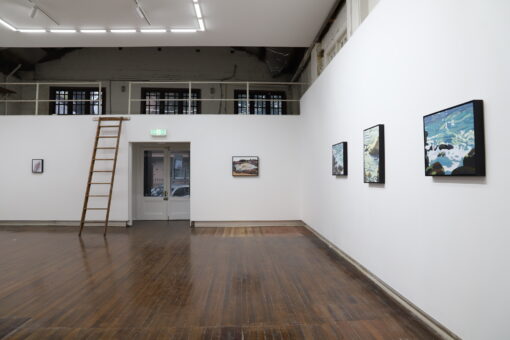
Thea Anamara Perkins, Shimmer, Installation image. Courtesy the artist and N.Smith Gallery.
What was your first exhibition, and why?
Thea Anamara Perkins’ exhibition Shimmer was our first. Thea was the first artist I asked to join the gallery.
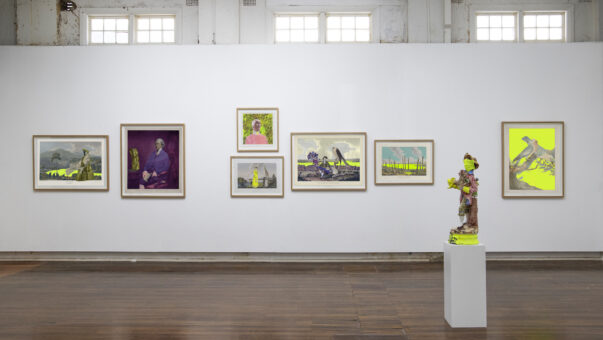
Joan Ross, I like to name everything after myself, Installation image. Courtesy the artist and N.Smith Gallery.
Who are you bringing to Sydney Contemporary and why?
The one and only Joan Ross. What’s Sydney Contemporary without Joan? We’re thrilled that as an emerging gallery we represent such an iconic and well-respected artist. Joan will be presenting a new digital animation, new hand-painted prints, and unique sculptures.
We spoke with Gallery Director, Margaret Moore from Moore Contemporary to talk about their presentation for Sydney Contemporary 2022.
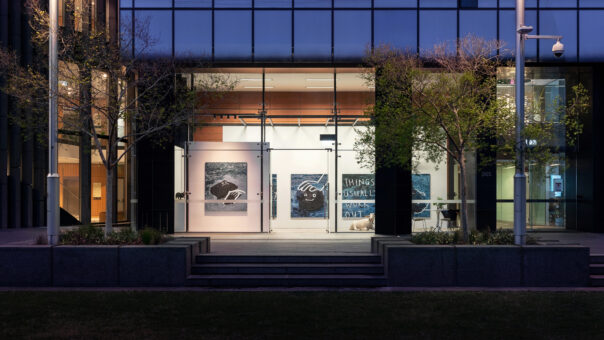
The gallery is located in Cathedral Square, Perth, can you elaborate on its location and why you chose to open here?
The Cathedral Square location is on the eastern edge of the Perth CBD. The Square itself is surrounded by the St Georges Cathedral, The State Buildings, including Como The Treasury Hotel, The Perth City Library and several corporate offices. It is home to three distinct art galleries and in close vicinity to other galleries making it an art destination. It is also within walking distance to AGWA, PICA and WA Museum.
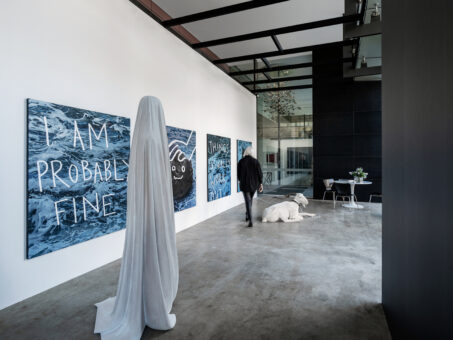
What are some career highlights, or exhibition highlights in the gallery to date?
MOORE CONTEMPORARY is well identified for promoting and presenting conceptually and materially diverse works in its commitment to and representation of significant contemporary art and artists.
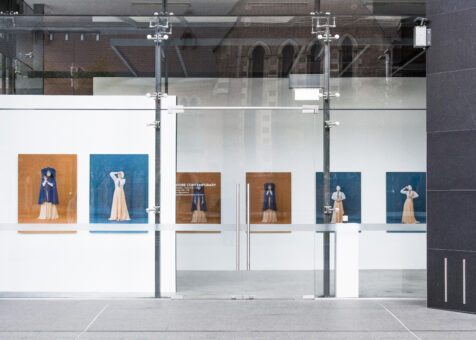
What was your first exhibition, and why?
The inaugural exhibition titled Project 01, featured new works by artists Rebecca Baumann, Marita Fraser, Jeppe Hein and Ian Strange. It was selected to celebrate the essence of MOORE CONTEMPORARY, presenting exceptional contemporary art by local and international artists. It presented painting, sculpture, photography and a custom window installation by Rebecca Baumann.
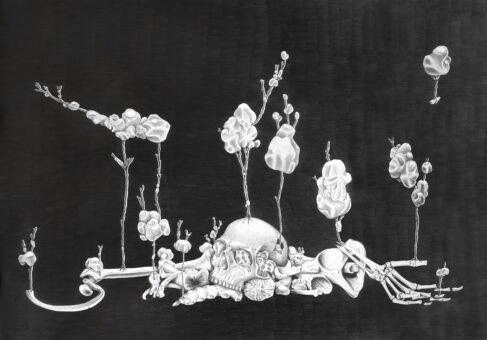
Erin Coates, Afterlife, 2021, Graphite on paper
78 x 100cm (framed). Courtesy of the artist and MOORE Contemporary.
Who are you bringing to Sydney Contemporary and why?
Artists, Abdul-Rahman Abdullah, Erin Coates, Dan McCabe and Matthew Hunt will show a mix of three-dimensional, free-standing works and two-dimensional wall works. Together they expand the concept theme of ‘In Plain Sight’. Narratives, text and symbolism each find voice in dynamic ways. In a largely monochromatic display high realism meets unadorned languages in a play upon duplicitous meaning while projecting that ideas can be hiding in plain sight literally and metaphorically.
We spoke with Artistic Director Mark Feary and Executive Director Tracy Burgess from Getrude Contemporary to talk about their presentation for Sydney Contemporary 2022.
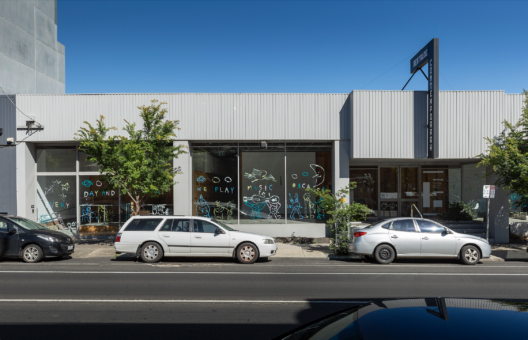
Jason Phu, some demons strolling around playing music all day and night because they have nothing better to do and it is very fun. Courtesy of Gertrude Contemporary. Photography by Christian Capurro.
The gallery is located in Preston, in Melbourne’s northern suburbs, can you elaborate on its location and why you chose to open here?
Preston is a growing hub for creativity – as artists have been pushed out of Melbourne’s inner suburbs by rising rent, many have moved north, creating a vibrant local atmosphere. Our neighbours include a local cinema, Perimeter Books, music venues, and many excellent bars and restaurants, including the iconic Cedars Bakery right next door. Our location allows our studio artists space to create large-scale works, and our exhibition space was designed as a responsive site by Edition Office, adapting to each exhibition’s needs. It is important that we house our main gallery and studios in a single, cohesive and accessible space. The community we foster through our combined studios and exhibition program is linked inextricably to the functionality of our spaces, and Preston’s history as home to factories and warehouses provide large, single-level buildings that are ideal to be adapted to creative work and presentation. Our building was, in a past life, a furniture store, and the large street-facing windows have proved to be a wonderful space to share art with the passing public, particularly during pandemic lockdowns.
We also have a satellite gallery space in Collingwood called Gertrude Glasshouse. This space is used primarily to present ambitious exhibitions by our cohort of studio artists. The location of this space, around the corner from our original home in Fitzroy, helps keep us connected to our long-time home and neighbouring galleries. This site allows us to present programming at a more intimate scale than our main gallery, giving us the opportunity to run concurrent projects and offer a wide variety of experiences to our visitors.
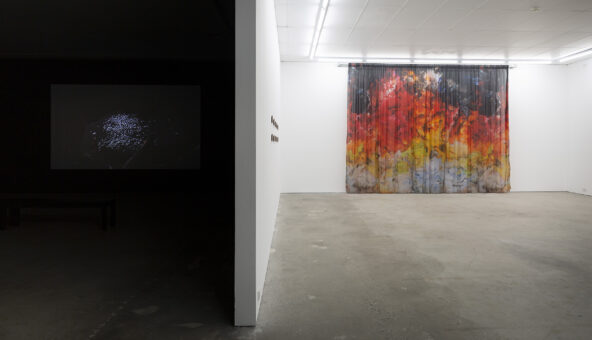
Installation view of Octopus 21/ On Fire, 2021, featuring work by Warraba Weatherall, Jemima Wyman, and Mavis Ngallametta at Gertrude Contemporary. Photography by Christian Capurro.
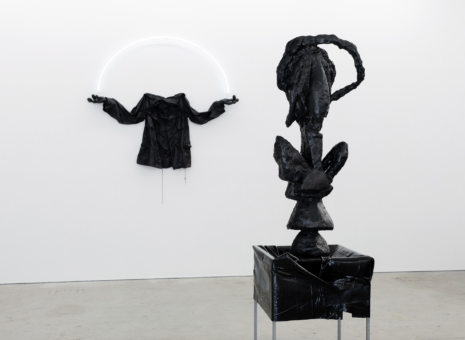
Installation image of Rob McLeish’s HEADLESS at Gertrude Contemporary. Photography by Christian Capurro.
What are some career highlights, or exhibition highlights in the gallery to date?
Recent highlights include Polyphonic Reverb, curated by Mark Feary, Atong Atem’s solo exhibition Everything in Remission and Contact High, a performance-based residency curated by Anador Walsh, culminating in two events in January this year.
Polyphonic Reverb features artists based in Australia and Aotearoa with cultural connections to the near pacific, particularly Polynesia and Melanesia. This project focused on voices reflecting the diasporic and migratory influence of the Pacific, and how these identities may be disembodied through distance and dislocation.
Everything in Remission featured a large-scale collage work alongside portraits of the artist’s parents and a rare foray for Atem into sculptural work. This exhibition was conceived as a self-portrait, in which photographic remnants from past projects and personal collections were brought together into an abstracted, textural environment, eschewing the representational quality of her work to date.
Coming out of a two-year period in which performance was engaged with primarily through the intermediaries of phone and laptop screens, Contact High set out to emphasise that which is lost through digital dissemination: action and dialogue, movement and sweat, laboured breath and foot falls, audiences and performers, dancers and spectators, dramaturgy and scores.
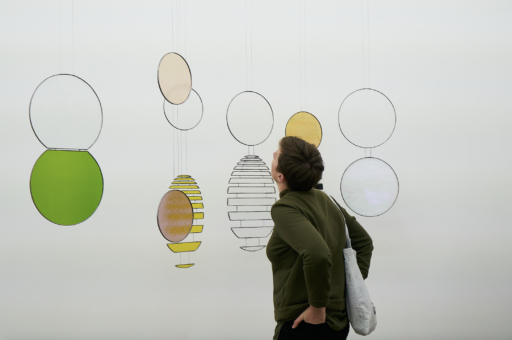
Visitors at the opening of Andrew Atchinson’s, …shaped by a vision that is always structured through his own multiple horizons of experience…, Gertrude Glasshouse. Photography by Machiko Abe.
What was your first exhibition, and why?
Gertrude was formed in Fitzroy in 1983 first as a studio complex, and in 1985 hosted its first exhibition to expand its reach and to provide a connection between the practices of its artists in residence and the visiting public. This interconnected, hybrid model, providing equal support to both the production and presentation of contemporary art, has been central to the organisation since. Gertrude’s first group exhibition included artists Bion Balding, Carole Bryan, Ben Creaney, Kim Donaldson, Merrin Eirth, Philip Judd, Catherine Martin, Will Mitchell, John MacKinnon, Jan Murray, Jan Nelson, Siobhan Ryan and Ann Weir.
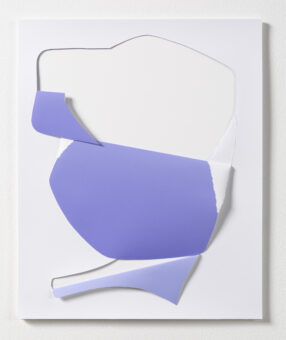
Mira Gojak, Cutting through #3, 2018, sliced photographic paper, 33.5 x 41.5 cm. Courtesy the artist and Gertrude Contemporary and Murray White Room, Melbourne.
Who are you bringing to Sydney Contemporary and why?
In 2022, we’re bringing a special archive of our annual Gertrude Editions to Sydney Contemporary. The Gertrude Edition is an annual fundraising initiative that contributes significant financial support to our not-for-profit gallery and artist studios. Each year, an alumnus of the Gertrude Studio Program is invited to contribute a work, released in an edition of 50 – often this will result in a pair of works or a series of works.
We’re opening our archive of past editions to showcase the breadth of influential artists that Gertrude has supported over our nearly 40 years of operating. Collectors will be given the opportunity to acquire works that speak to the local Australian artistic community’s strength and diversity, while also supporting a key institution that allows our artists to thrive. Artists include Elizabeth Newman, Brent Harris, Mira Gojak, Renee So, Damiano Bertoli, Paul Yore, Ann Marie-May and Jon Campbell.
We spoke with Gallery Director, Rachael Fry from C. Gallery to talk about their presentation for Sydney Contemporary 2022.
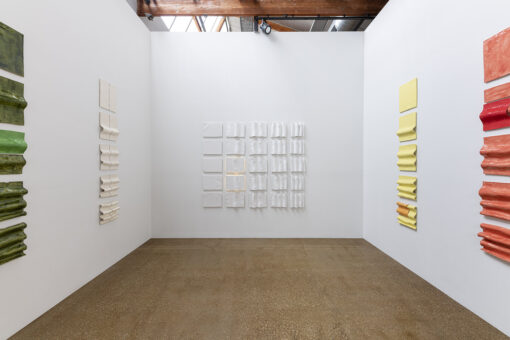
Ben Mazey, Making Nice Things, Installation Image. Photo by Simon Strong.
The gallery is located in Melbourne, can you elaborate on its location and why you chose to open here?
The gallery is located in the heart of the post-industrial Cremorne precinct, one of the creative hubs of Melbourne where the north and the south converge. The shell of the space has the character and charm of its former glory as a knitting mill with diffused natural light and exposed six meter Oregon beams flanking the length of the building. The white gallery space is housed within the industrial exterior to provide a blank canvas for artists to explore narratives within a historic setting.
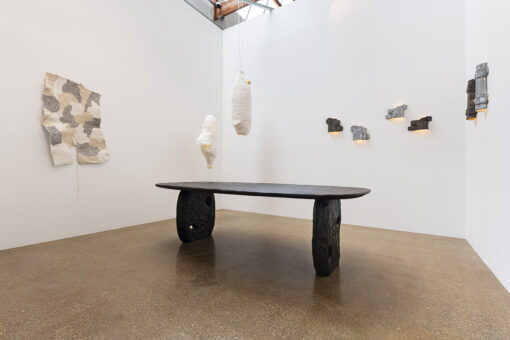
Doug Johnston, Linde Freya Tangelder and Benoit Viaene, Traditional Techniques Contemporary Modes, Installation Image. Photo by Simon Strong.
What are some career highlights, or exhibition highlights in the gallery to date?
We are the new kids on the block so we are approaching our first year anniversary, and within that time we are very proud of what we have achieved including two exhibitions (during lockdown) featuring the work of functional and visual artists from Sweden, Spain, New York and Belgium as well as the first solo exhibition of New Zealand born Ben Mazey. We look forward to upcoming exhibitions by Claudia Lau, Ruth Allen and Jeremy Anderson.
What was your first exhibition, and why?
Our first exhibition was a group show by the functional artist Jenny Nordberg (Sweden) and sculptor José Manuel Castro López (Spain). I was interested by both the dichotomy and symbiosis of the works of these two artists. The atemporal glow of Nordberg’s silvered mirrors stand in such contrast to the gravity of López’s lush stone carvings and yet both elicit the impression of the human touch and the wonder of our own beguiling existence.
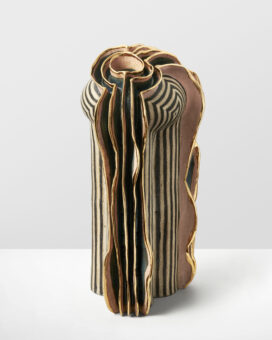
Jeremy Anderson, Piccolo 2022 Stoneware, glaze, 22 karat, gold lustre, 38 x 17 x 20 cm. Courtesy the artist and C. Gallery.
Who are you bringing to Sydney Contemporary and why?
We will be bringing a mixture of functional and visual artists we have shown to date including, Jenny Nordberg, Doug Johnston, Ben Mazey, Linde Freya Tangelder and José Manuel Castro López, as well as work for upcoming exhibitions by artists Jeremy Anderson, Claudia Lau and John Wardle.
We spoke to Gallerist, Anette Larkin from Annette Larkin Fine Art to talk about their presentation for Sydney Contemporary 2022.
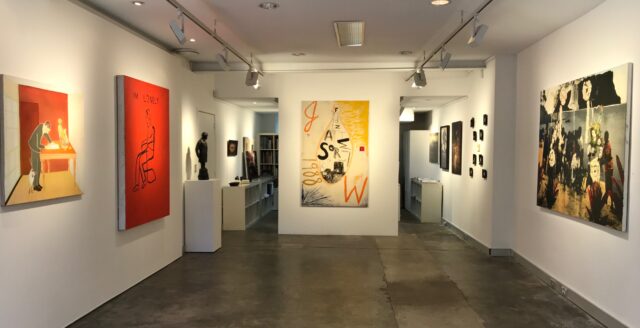
The gallery is located in Paddington, NSW. Can you elaborate on its location and why you chose to open here?
The gallery is located at 8 Soudan Lane, Paddington, in the same building as Roslyn Oxley9 Gallery, and in the Paddington Art Precinct where there are now 9 galleries all within walking distance. I moved here in 2016, and before that I was located at 2 Danks Street, Waterloo where I learnt to appreciate the positives of being located very closely to my peers.
What are some career highlights, or exhibition highlights in the gallery to date?
At Christie’s I developed a Contemporary Art department, which had 5 very successful auctions from 2000-2006, and changed the market/environment in Australia for contemporary art at auction, while also giving strength to the primary market.
Representing the Robert Klippel Estate, Estate of Carl Plate and the oeuvre of Michael Johnson with a particular focus on 1960-1980 have all been incredible highlights.
I have worked with some of the most outstanding private, corporate and museum collections in acquisitions, management, valuing and deaccessioning, but due to confidentiality of clients I cannot elaborate further.
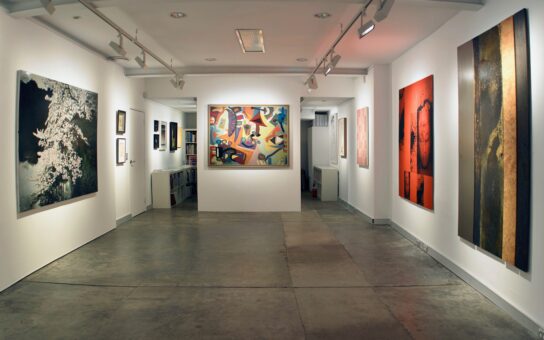
What was your first exhibition, and why?
My first exhibition in 2009 was titled Big Names, Little Sculptures. My first space at 2 Danks Street was very small, but I had big ideas. It included sculptural work by Hany Armanious, Lyndon Dadswell, Inge King, Shaun Gladwell, Ricky Swallow, Bronwyn Oliver, Clement Meadmore, Jean Arp etc… It launched the secondary market exhibition side of my business.
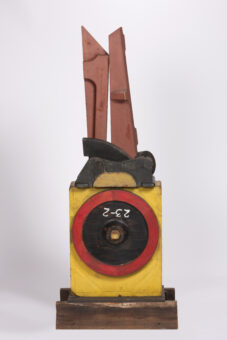
Robert Klippel (1920-2001), RK757, 1989, wood assemblage, 182 x 72.5 x 39.5 cm © Andrew Klippel. Courtesy of The Robert Klippel Estate, represented by Annette Larkin Fine Art, Sydney and Galerie Gmurzynska, Zurich.
Who are you bringing to Sydney Contemporary and why?
My exhibition will have large wooden sculptural pieces by Robert Klippel. The works were made between 1982-1989. The last exhibition of wooden pieces by Klippel was at Carriageworks with Anna Schwartz Gallery over 10 years ago, and they looked outstanding. It was my dream to see them again in this environment under the banner of Annette Larkin Fine Art. Robert Klippel enjoyed the company of the younger artist Michael Johnson, and in 1974 they together created a work titled Big Red that is now in the Art Gallery of Western Australia’s collection. To celebrate their friendship and the strong links between their work – albeit that one is a painter and the other a sculptor – will be compelling. My stand at Sydney Contemporary will also look at works on paper by these artists and a few of their peers.
We spoke to Gallery Director, Jack Willet from 1301 SW to talk about their presentation for Sydney Contemporary 2022.
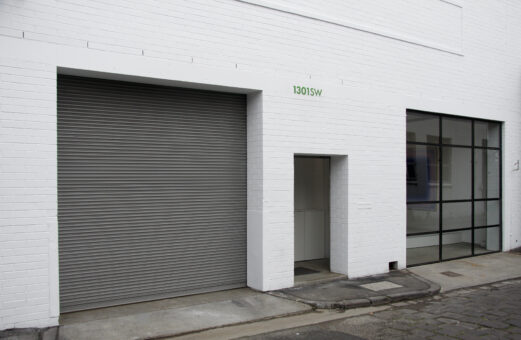
External Image of 1301SW. Courtesy of 1301SW, Melbourne.
The gallery is located in South Melbourne, can you elaborate on its location and why you chose to open here?
We spent some time looking for a location through the concluding haze of COVID-19 in the second half of 2021. The focus of our needs was a sizable freestanding space accessible to a wide variety of visitors, so it needed to be central. Additionally, we wanted to be in context, but with an air of starting something new. So with ACCA, Buxton Contemporary and the NGV a short stroll away, South Melbourne seemed like an ideal neighbourhood.
The George Street site offered a great deal of potential, with an abundance of natural light via the saw-tooth ceiling and two large spaces, one for a gallery and stock room and the other our office and viewing room. In the hands of architect Chris Connell, we have built something very special with a couple of key spatial decisions that both our artists and visitors are clearly engaged with.
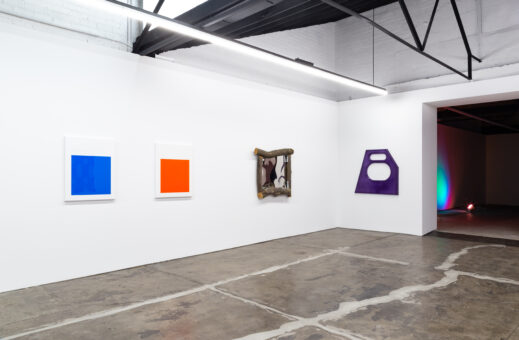
Jonny Niesche, An eerieness on the Plain, Installation Image. Courtesy of 1301SW, Melbourne. Image by: André Piguet
What are some career highlights, or exhibition highlights in the gallery to date?
Well, we are only one show into a very exciting exhibition program. But since our first public outing at the Melbourne Art Fair in February, our artists have presented significant exhibitions in a number of key institutions. Some highlights include Philippe Parreno’s recent takeover of the Rotunda at Paris’ Bourse de Commerce, Ann Veronica Janssens installation also in Paris at the Panthéon, Mikala Dwyer’s significant commission for ACMI’s Light exhibition, and Alicia Frankovich’s major exhibition Atlas of Anti-Taxonomies in Christchurch. Not to mention the exceptional programming our sister galleries — Starkwhite in Auckland and 1301PE in Los Angeles — have been presenting in 2022.
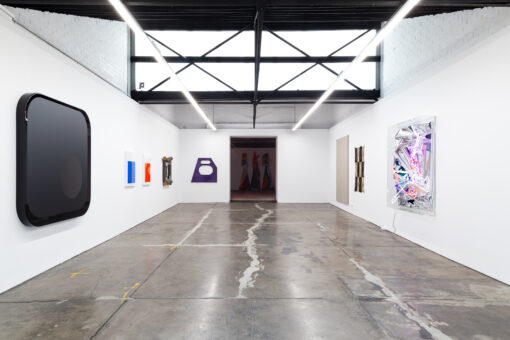
Jonny Niesche, An eerieness on the Plain, Installation Image. Courtesy of 1301SW, Melbourne. Image by: André Piguet
What was your first exhibition, and why?
We opened with something that would set the trend for what is to come. An eeriness on the Plain is an exhibition I worked on with artist Jonny Niesche, presenting works that explore minimalist, abstract and conceptual tendencies in contemporary art and how they talk of a sense of eeriness and artistic monotheism. Featuring an array of exceptional artists from both here and abroad, An eeriness on the Plain presented new and recent works by Rebecca Baumann, Alexandra Bircken, Andy Boot, Mikala Dwyer, Lewis Fidock, Alicia Frankovich, Ann Veronica Janssens, Lucina Lane, Gerold Miller, David Ostrowski, Anselm Reyle, and Blair Thurman. The larger conceptual concerns of this exhibition will be a continuing motif of the gallery, along with our desire to create a meaningful contextualisation between works, artists, audiences and collections.
The contextualisation of the local and the international is at the core of 1301SW, offering an opportunity to build meaningful dialogues between the artists and artworks, something we believe both our larger audience and collector base will find deeply engaging. This is represented by a key group of artists we are working with being predominantly international, such as Ann Veronica Jassens, Philippe Parreno, Diana Thater, Rirkrit Tiravanija and Pae White, coupled with historic and contemporary artists from New Zealand and Australia, including: Billy Apple, Rebecca Baumann, Mikala Dwyer, Jonny Niesche and Gordon Walters.

Billy Apple, Rainbow Triptych, 1965, screenprint on paper, 74 x 132 cm. Courtesy of the artist and 1301 SW, Melbourne.
Who are you bringing to Sydney Contemporary and why?
For the 2022 edition of Sydney Contemporary we are partnering with Auckland’s Starkwhite to show a group of significant works by internationally acclaimed artists working across both galleries, including: Billy Apple, Petra Cortright, Bill Henson, Gerold Miller, Jonny Niesche, Fiona Pardington, and more.
Our presentation will include Apple’s noteworthy piece AC / DC (Artist’s Cut / Dealer’s Cut) (1986), which will be the first Australian presentation of the esteemed artist since his passing in 2021. This work exemplifies Apple’s conceptual re-contextualisation, here crafting a multifaceted definition for the recognisable title, while making “divine proportions” or a “golden ratio” of the canvas for commercial division — a dotted line cut at the 61.8/38.2 mark, 38.2 percent being the dealers’ cut.
American artist Petra Cortright and Germany’s Gerold Miller will present pictorial works utilising distinct materials and techniques benefiting from contemporary technologies and precise craftmanship. Cortright’s recent works are indicative of her now renowned digital paintings, in which she fuses two schools of gestural painting: the layering and rapid brush strokes of the Abstract Expressionists with the soft blurring of the Impressionists. While Miller’s works explore the artist’s attempt to pinpoint where sculptural space ends and the painted image begins, utilising an aluminium base coated in glossy lacquer to present bold monochromatic tones.
Another notable dialogue within our booth will be the presentation of arguably Australia and New Zealand’s most acclaimed photographers, Bill Henson and Fiona Pardington. Sitting side-by-side, historically significant works will showcase the artists’ distinct engagements with atmosphere, allegory, and attraction.
All these works, along with others to be added, speak to some of the larger views which keep cropping up for us: context and dialogue, references to the historic and contemporary, being local and international. These are works of exceptional quality by a group of artists I greatly admire and want to share with our larger community.
Image Credits:
Jonny Niesche, An eerieness on the Plain, Installation Image. Courtesy of 1301SW, Melbourne.Image by: André Piguet
Jonny Niesche, An eerieness on the Plain, Installation Image. Image by: André Piguet.
External Image of 1301SW. Courtesy of 1301SW, Melbourne.
Billy Apple, Rainbow Triptych, 1965, screenprint on paper, 74 x 132 cm. Courtesy of the artist and 1301 SW, Melbourne.